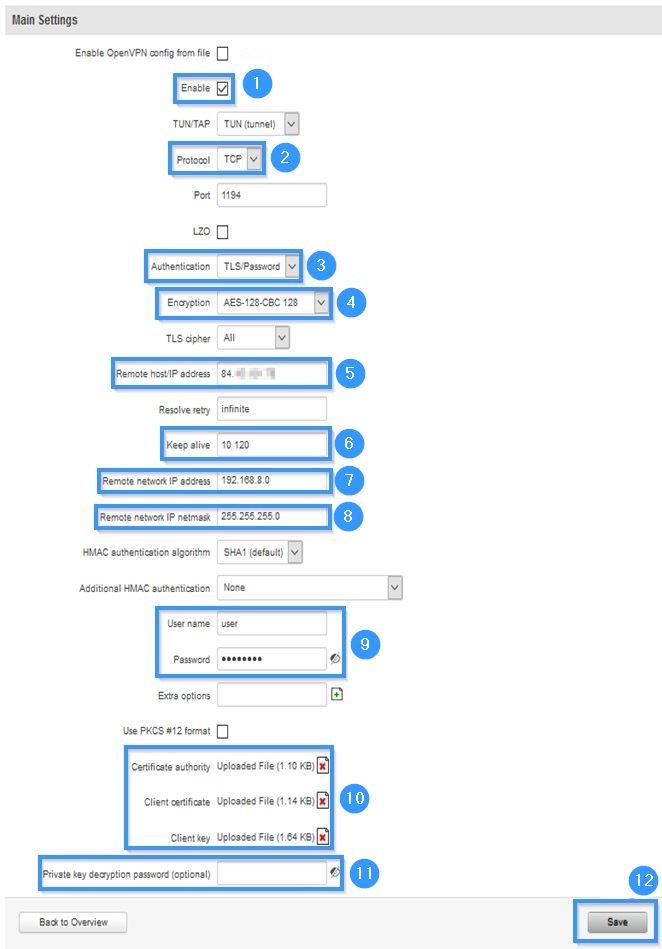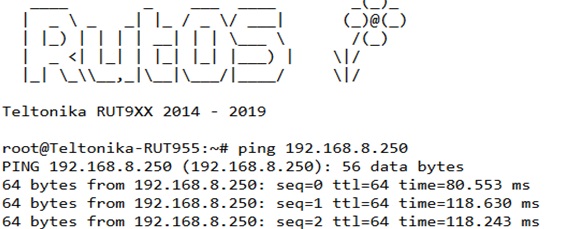Template:Netoworking rutxxx configuration example mikrotik openvpn
Introduction
OpenVPN is an open-source software application that implements virtual private network (VPN) techniques for creating secure point-to-point or site-to-site connections in routed or bridged configurations and remote access facilities.
This guide provides a configuration example with details on how to configure OpenVPN connection between MikroTik and RUTxxx routers. The server will be MikroTik device and the client will be our RUTxxx router.
Prerequisites
- One RUTxxx router of any type
- One Mikrotik router (this configuration example was created using Mikrotik rb750gr3)
- Server must have a Public Static or Public Dynamic IP address
- At least one end device (PC, Laptop) to configure the routers
- WinBox application
Configuration scheme
[[File:|border|class=tlt-border]]
Server (Mikrotik) configuration
Connect to MikroTik by using WinBox application and press New Terminal.
Now create certificates by using these commands (these will be valid for 10 years):
/certificate
add name=ca-template common-name=example.com days-valid=3650 key-size=2048 key-usage=crl-sign,key-cert-sign
add name=server-template common-name=*.example.com days-valid=3650 key-size=2048 key-usage=digital-signature,key-encipherment,tls-server
add name=client-template common-name=client.example.com days-valid=3650 key-size=2048 key-usage=tls-client
Created certificates will need signing, use these commands:
sign ca-template name=ca-certificate
sign server-template name=server-certificate ca=ca-certificate
sign client-template name=client-certificate ca=ca-certificate
Now you need to export those certificates:
/certificate
export-certificate ca-certificate export-passphrase=""
export-certificate client-certificate export-passphrase=12345678
Now go to Files and export those certificates by simply dragging them to your desktop.
Now go back to Terminal and create a separate pool of IP addresses for clients by using this command:
/ip
pool add name="vpn-pool" ranges=192.168.8.10-192.168.8.99
Instead of editing the default encrypted profile, we need to create a new one. Assumption is your MikroTik will also be a DNS server. And while at it, you can create a bit more imaginative user/password:
/ppp
profile add name="vpn-profile" use-encryption=yes local-address=192.168.8.250 dns-server=192.168.8.250 remote-address=vpn-pool
secret add name=user profile=vpn-profile password=password
Adjust firewall by using this command:
/ip firewall filter
add chain=input protocol=tcp dst-port=1194 action=accept place-before=0 comment="Allow OpenVPN"
Now enable OpenVPN server interface:
/interface ovpn-server server
set default-profile=vpn-profile certificate=server-certificate require-client-certificate=yes auth=sha1 cipher=aes128,aes192,aes256 enabled=yes
Client (RUTxxx) configuration
Access RUTxxx WebUI and go to Service > VPN > OpenVPN. There create a new configuration by selecting role Client, writing New configuration name (anything you want) and pressing Add New button. It should appear after a few seconds. Then press Edit.
Then apply the following configuration.
- Enable Instance.
- Select Protocol (TCP).
- Select Authentication (TLS/Password).
- Select Encryption (AES-128-CBC 128).
- Write Remote host/IP address (MikroTik public IP address).
- Write Keep alive (10 120).
- Write Remote network IP address (192.168.8.0).
- Write Remote network IP netmask (255.255.255.0).
- Write User name and Password which you created on Mikrotik (you created it by using this command: secret add name=user profile=vpn-profile password=password).
- Upload Certificate authority, Client certificate, Client key (use those exported files).
- Write Private key decryption password (you created it by using this command: export-certificate client-certificate export-passphrase=12345678).
- Press Save.
Testing configuration
Go to Status > Routes and in the Active IP Routes table you should see these two new routes.
Try to ping the remote VPN endpoint via CLI or SSH using this command:
ping 192.168.8.250







